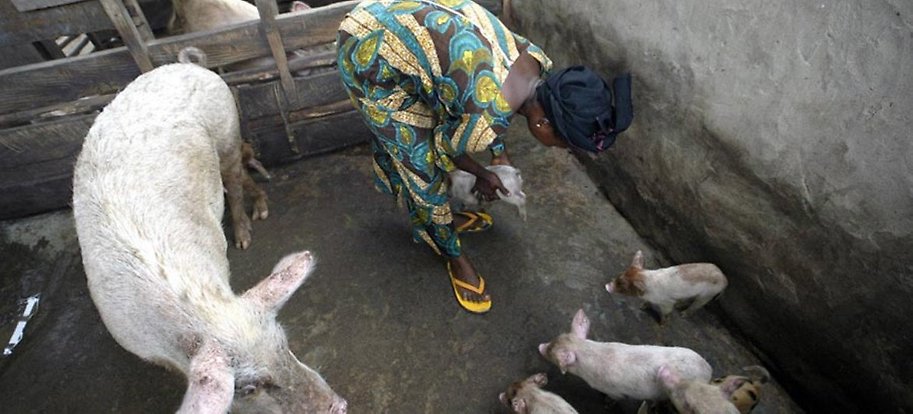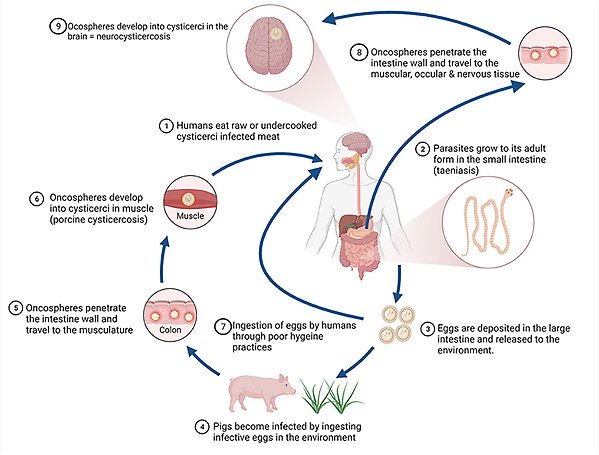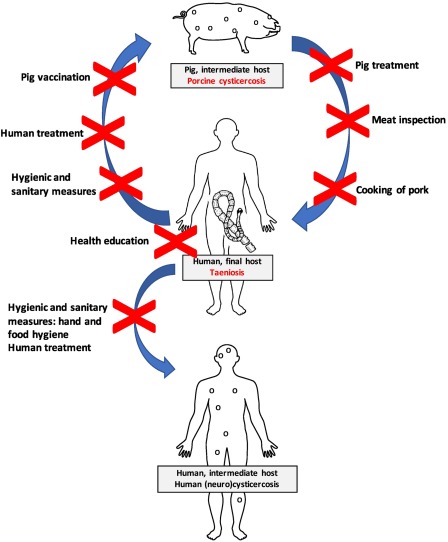A holistic One Health approach to address Taenia solium in Uganda: Exploring the gender structures in WASH and the pork value chain

Grundinformation
- Period: 2024-01-01 – 2028-12-31
Background
Taenia solium, more commonly known as pork tapeworm, is a zoonotic parasite that has long been considered as a Neglected Tropical Disease by the World Health Organization (Donadeu et al., 2016). It is responsible for a heavy burden of disease that impacts both human and animal health, and has negative effects on agricultural productivity (Larkins et al., 2022; Ngwili et al., 2023; Phiri et al., 2003; Trevisan et al., 2017). There are several common strategies to address T. solium, but most focus narrowly on particular transmission pathways—particularly of humans or pigs, but rarely the environment. Hence, in spite of initial promising results of these more known management and preventive strategies, they have been slow to elicit sustainable change as many interventions have worked in silos or have failed to consider certain cultural, environmental and societal factors.

Figure 1. Life Cycle of T. solium (Soare et al., 2022)

Figure 2. Life cycle of Taenia solium and possible interventions (X) which are considered to interrupt the life cycle in endemic areas (de Coster et al., 2018)
Studies done in Uganda and Eastern Zambia have shown that gender roles and beliefs expose women, men and children differently to T. solium; as well as influence how they perform pig rearing activities—e.g. having varying views on letting pigs roam freely to clean-up and eat human faeces in areas that still practice open-defecation (Ngwili et al., 2022, 2023; Thys et al., 2016). Thus, these effects make gender a crucial structure to consider and review for holistic interventions, especially in the area of Water, Sanitation and Hygiene (WASH).
The general sentiment that resolving this complex issue requires more collaborative, contextualised and holistic studies and interventions has led several researchers to promote the One Health approach (Mumford et al., 2023) as a framework to better understand and successfully address this particular zoonosis (that is often overlooked in WASH) (Braae et al., 2019; Ngwili et al., 2021, 2023). However, in spite of the cross-cutting implications of gender on the outcomes of this approach, gender inequality and other forms of social marginalization have only recently been considered and talked about.
In the Ugandan context—with its existing gender gaps (Ali et al., 2016; Campbell, 2017)—it becomes vital to utilize a One Health approach that mainstreams gender, and acknowledge it as a major driving force in achieving health and wellbeing for both humans and nonhuman animals (Cataldo et al., 2023). Moreover, in the wider East African context, there does not seem to be any in-depth work done yet that is focused on how existing gender structures in the farming environment and the agriculture and public health sectors reflect on people’s risk perception of T. solium. Gaube et al. (2019) explain that understanding health risk perceptions is important as it influences one’s behaviour in matters of health and sanitation—of which play huge roles in (the prevention of) transmitting the parasite. Additionally, exploring the implications of gender structures on the pigs’ health and wellbeing—as a direct result of their human caretakers’ actions—can further elaborate the persistence of T. solium.
This research intends to build on previous work of the International Livestock Research Institute (ILRI) on T. solium in Uganda and East Africa, with the overall aim to develop an understanding on the socioecological structures, such as gender, in WASH implementation that continuously leads to the transmission of Taenia solium in pig farming communities in Uganda.
The research will utilize the following frameworks to give structure in the development and analysis:
- The Gender considerations in One Health by Galiè et al. (2024)
- The Gender Structure framework by Risman and Davis (2013), taken in tandem with
- The Socio-ecological Framework for parasitic infections by Wang et al. (2023).
Generating this knowledge can provide the foundation in developing more inclusive, contextualized and holistic WASH interventions and policies that are better at preventing the spread of T. solium. In the long run, doing so can also lead to improved and more gender equitable outcomes in the area—in terms of both health and agriculture.
Samarbetsparter
- SWEDESD
- Centre for Gender Research (Uppsala University)
Projektmedlemmar
Referenser
Ali, D., Bowen, D., Deininger, K., & Duponchel, M. (2016). Investigating the Gender Gap in Agricultural Productivity: Evidence from Uganda. World Development, 87, 152–170. https://doi.org/10.1016/j.worlddev.2016.06.006
Braae, U. C., Gabriël, S., Trevisan, C., Thomas, L. F., Magnussen, P., Abela-Ridder, B., Ngowi, H., & Johansen, M. V. (2019). Stepwise approach for the control and eventual elimination of Taenia solium as a public health problem. BMC Infectious Diseases, 19(1), 182. https://doi.org/10.1186/s12879-019-3812-y
Campbell, D. (2017, July 25). Culture and Gender Inequality in Uganda. Uganda For Her. https://uganda4her.org/culture-gender-inequality-uganda/
Cataldo, C., Bellenghi, M., Masella, R., & Busani, L. (2023). One Health challenges and actions: Integration of gender considerations to reduce risks at the human-animal-environmental interface. One Health, 16, 100530. https://doi.org/10.1016/j.onehlt.2023.100530
de Coster, T., Van Damme, I., Baauw, J., & Gabriël, S. (2018). Recent advancements in the control of Taenia solium: A systematic review. Food and Waterborne Parasitology, 13, e00030. https://doi.org/10.1016/j.fawpar.2018.e00030
Donadeu, M., Lightowlers, M. W., Fahrion, A. C., Kessels, J., & Abela-Ridder, B. (2016). Taenia solium:WHO endemicity map update. Weekly Epidemiological Record, 49(50), 595–599.
Galiè, A., McLeod, A., Campbell, Z. A., Ngwili, N., Terfa, Z. G., & Thomas, L. F. (2024). Gender considerations in One Health: A framework for researchers. Frontiers in Public Health, 12, 1345273. https://doi.org/10.3389/fpubh.2024.1345273
Gaube, S., Lermer, E., & Fischer, P. (2019). The Concept of Risk Perception in Health-Related Behavior Theory and Behavior Change (pp. 101–118). https://doi.org/10.1007/978-3-030-11456-5_7
Larkins, A., Bruce, M., Bari, C. D., Devleesschauwer, B., Pigott, D. M., & Ash, A. (2022). A scoping review of burden of disease studies estimating disability-adjusted life years due to Taenia solium. PLOS Neglected Tropical Diseases, 16(7), e0010567. https://doi.org/10.1371/journal.pntd.0010567
Mumford, E. L., Martinez, D. J., Tyance-Hassell, K., Cook, A., Hansen, G. R., Labonté, R., Mazet, J. A. K., Mumford, E. C., Rizzo, D. M., Togami, E., Vreedzaam, A., & Parrish-Sprowl, J. (2023). Evolution and expansion of the One Health approach to promote sustainable and resilient health and well-being: A call to action. Frontiers in Public Health, 10. https://www.frontiersin.org/journals/public-health/articles/10.3389/fpubh.2022.1056459
Ngwili, N., Ahimbisibwe, S., Sentamu, D. N., Thomas, L. F., & Ouma, E. (2023). Structure of the pork value chain in Northern Uganda: Implications for Taenia solium control interventions. Frontiers in Veterinary Science, 10, 1177526. https://doi.org/10.3389/fvets.2023.1177526
Ngwili, N., Johnson, N., Wahome, R., Githigia, S., Roesel, K., & Thomas, L. (2021). A qualitative assessment of the context and enabling environment for the control of Taenia solium infections in endemic settings. PLOS Neglected Tropical Diseases, 15(6), e0009470. https://doi.org/10.1371/journal.pntd.0009470
Ngwili, N., Thomas, L., Githigia, S., Johnson, N., Wahome, R., & Roesel, K. (2022). Stakeholders’ Knowledge, Attitude, and Perceptions on the Control of Taenia solium in Kamuli and Hoima Districts, Uganda. Frontiers in Veterinary Science, 9. https://doi.org/10.3389/fvets.2022.833721
Phiri, I. K., Ngowi, H., Afonso, S., Matenga, E., Boa, M., Mukaratirwa, S., Githigia, S., Saimo, M., Sikasunge, C., Maingi, N., Lubega, G. W., Kassuku, A., Michael, L., Siziya, S., Krecek, R. C., Noormahomed, E., Vilhena, M., Dorny, P., & Lee Willingham III, A. (2003). The emergence of Taenia solium cysticercosis in Eastern and Southern Africa as a serious agricultural problem and public health risk. Acta Tropica, 87(1), 13–23. https://doi.org/10.1016/S0001-706X(03)00051-2
Risman, B. J., & Davis, G. (2013). From sex roles to gender structure. Current Sociology, 61(5–6), 733–755. https://doi.org/10.1177/0011392113479315
Soare, C., Garcia-Ara, A., Seguino, A., Uys, M., & Thomas, L. F. (2022). Maximising Societal Benefit From the Control of Neglected Zoonoses: Identifying Synergies and Trade-Offs in the Control of Taenia solium. Frontiers in Veterinary Science, 8, 794257. https://doi.org/10.3389/fvets.2021.794257
Thys, S., Mwape, K. E., Lefèvre, P., Dorny, P., Phiri, A. M., Marcotty, T., Phiri, I. K., & Gabriël, S. (2016). Why pigs are free-roaming: Communities’ perceptions, knowledge and practices regarding pig management and taeniosis/cysticercosis in a Taenia solium endemic rural area in Eastern Zambia. Veterinary Parasitology, 225, 33–42. https://doi.org/10.1016/j.vetpar.2016.05.029
Trevisan, C., Devleesschauwer, B., Schmidt, V., Winkler, A. S., Harrison, W., & Johansen, M. V. (2017). The societal cost of Taenia solium cysticercosis in Tanzania. Acta Tropica, 165, 141–154. https://doi.org/10.1016/j.actatropica.2015.12.021
Wang, Y.-C., Namsanor, J., Law, A., & Sithithaworn, P. (2023). A socio-ecological framework for examining foodborne parasitic infection risk. Acta Tropica, 244, 106957. https://doi.org/10.1016/j.actatropica.2023.106957
